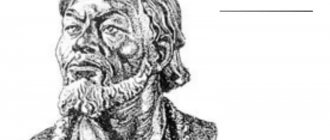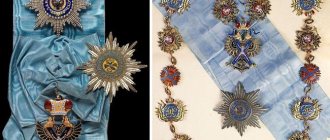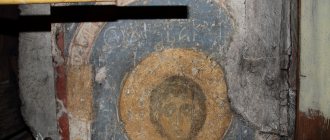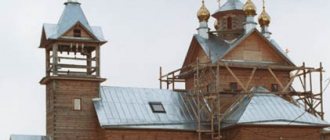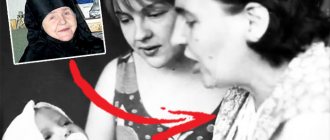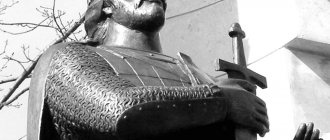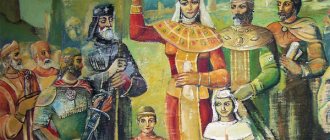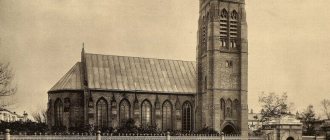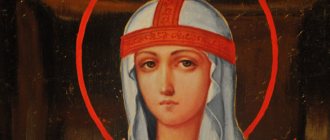Development of Vladimir and surrounding areas
Having become “the autocrat of the entire Suzdal land,” Andrei Bogolyubsky moved the capital of the principality to Vladimir-on-Klyazma. From this moment on, the city and its surroundings begin to be actively developed. In 1158-1164, Andrei Bogolyubsky added the so-called New City to the Vladimir Kremlin - an earthen fortress with two gate towers made of white stone.
Plan of Vladimir-on-Klyazma showing the locations of different parts of the city
View of ancient Vladimir, model reconstruction based on N.N. Voronin’s version. Museum of Vladimir
Golden Gate
To this day, of the five outer gates of the New City fortress, only one has survived - the Golden Gate, which was bound in gilded copper. The Golden Gate was used as a defensive structure and as a triumphal arch. They decorated the main entrance to the richest princely-boyar part of the city.
This was the most ceremonial gate of the city in the 12th-13th centuries. The Ipatiev Chronicle reports that the prince “made them with gold,” meaning that they were covered with sheets of gilded copper, which shone brightly in the sun and amazed the imagination of contemporaries. Close to the gate from the north and south there were embankments with deep ditches on the outside. A bridge passed through the ditches from the gate, leading out of the city. The height of the arch reached 14 meters. Massive oak gates, hanging on wrought-iron hinges, adjoined the arched lintel.
Golden Gate, Vladimir
Diorama of the assault on Vladimir by the Horde in 1238. Located in the Golden Gate in the military history museum. In the foreground is the Golden Gate, second photo: Dmitry Bakulin
Assumption Cathedral
The original white stone cathedral was built under Grand Duke Andrei Bogolyubsky in 1158-1160. Some sources indicate April 8, 1158, as the date when Prince Andrei Bogolyubsky laid the foundation of the building on a high mountain above the river. The main motive for the construction of such a large temple was the political position of the Vladimir principality, so the prince allocated a tenth of his personal income to it. For this reason, the height of the Vladimir Assumption Cathedral was equal to the height of the St. Sophia Cathedral in Kyiv.
Already in 1161 the cathedral was painted. According to V. Tatishchev's message, German craftsmen were involved in construction and painting, who were sent at the request of Andrei by Emperor Frederick Barbarossa.
Assumption Cathedral in Vladimir, modern photo
Assumption Cathedral of Andrei Bogolyubsky. Reconstruction by Sergei Zagraevsky.
The princely castle-residence “Bogolyubovo” and the Church of the Intercession on the Nerl.
Ancient Bogolyubovo (reconstruction), museum of Bogolyubovo, LJ photo - maximus101.livejournal.com Bogolyubovo (under the original name Bogolyuby) was founded in 1158 by order of Prince Andrei in this place, since the Nerl connected the Oka basin with the upper Volga basin.
The founding of Bogolyubov was associated by the clergy with the legend of the appearance of the Mother of God to Prince Andrei: when Prince Andrei was carrying the icon of the Mother of God from Vladimir to Rostov, 10 km before Vladimir the horses stopped, and by no means could they be forced to go further. We spent the night at this place. That night the appearance of the Mother of God took place[3], and on this very place the Bogolyubovo and Bogolyubsky monasteries were founded. According to the research of Sergei Zagraevsky [1] Zagraevsky S. V. Historical topography of the pre-Mongolian Bogolyubov // Electronic scientific. bib on ancient Russian history. architecture "RusArch", 2021. in pre-Mongol times, the city was surrounded by two contours of fortifications. The internal contour is completely or partially white stone fortifications with a perimeter of about 1.5 km. The outer contour is wood-earth fortifications with a perimeter of about 2.9 km. Inside the white-stone city fortifications there was a white-stone palace and temple complex (“castle”) of Prince Andrei Bogolyubsky.
Church of the Intercession on the Nerl in the 12th century. Reconstruction
Sergei Zagraevsky. Reconstruction of Andrei Bogolyubsky's castle
The Church of the Intercession on the Nerl was built as a monument to the successful campaign of Andrei Bogolyubsky against the Bulgarians in 1164. At the same time, it was a monument to the son of Prince Andrei Izyaslav, who died in this campaign. The dedication of the temple to the Intercession of the Virgin Mary was perhaps a first for the Russian lands, because this holiday was established by Andrei Bogolyubsky without the consent of the Kyiv Metropolitan.
To estimate the size of Bogolyubov under Andrei, you can compare them with the size of other ancient Russian cities: Kyiv (city of Yaroslav) - the perimeter of the fortifications is about 3.5 km, Smolensk (city of Rostislav) - about the same. Pereslavl-Zalessky - 2.5 km, Vladimir (Monomakhov, or Pecherny, city) - also about 2.5 km, Yuryev-Polsky - 2 km, Suzdal - 1.4 km. In Dmitrov, Yaroslavl (Chopped City) and Przemysl of Moscow - about 1 km, in Zvenigorod and Moscow (fortress of 1156) - about 800 m. Thus, Bogolyubovo was one of the largest cities not only in North-Eastern Rus', but also in by all-Russian standards.
The active and monumental construction begun by Andrei Bogolyubsky in Vladimir was supposed to reflect the strength and political significance of his principality and this also applied to his newly founded country residence. The Grand Duke lived in his palace for the rest of his life, and here he was killed as a result of a boyar conspiracy in 1174. Bogolyubov's growth stopped after the death of Andrei Bogolyubsky. The palace, located today on the territory of the Bogolyubsky Monastery, is the only civil building of pre-Mongol Rus' that has survived to this day, at least partially.
A surviving fragment of Bogolyubsky Castle
LiveInternetLiveInternet
Andrei Yuryevich Bogolyubsky (circa 1111-June 29, 1174) - Prince of Vyshgorod in 1149, 1155. Prince of Dorogobuzh in 1150-1151, Ryazan (1153). Grand Duke of Vladimir in 1157-1174. Son of Yuri Vladimirovich Dolgoruky and the Polovtsian princess, daughter of Khan Aepa Asenevich. During the reign of Andrei Bogolyubsky, the Vladimir-Suzdal principality achieved significant power and was the strongest in Rus', in the future becoming the core of the modern Russian state. He received the nickname “Bogolyubsky” from the name of the princely castle Bogolyubovo near Vladimir, his favorite residence. In 1146, Andrei, together with his older brother Rostislav, expelled Izyaslav Mstislavich’s ally, Rostislav Yaroslavich, from Ryazan, and he fled to the Polovtsians. In 1149, after Yuri Dolgoruky occupied Kyiv, Andrei received Vyshgorod from his father, participated in the campaign against Izyaslav Mstislavich in Volyn and showed amazing valor during the assault on Lutsk, in which Izyaslav’s brother Vladimir was besieged. After this, Andrei temporarily owned Dorogobuzh in Volyn. In 1153, Andrei was placed by his father on the reign of Ryazan, but Rostislav Yaroslavich, who returned from the steppes with the Polovtsians, kicked him out. Ivan Bilibin. After the death of Izyaslav Mstislavich and Vyacheslav Vladimirovich (1154) and the final approval of Yuri Dolgoruky in Kyiv, Andrei was again planted by his father in Vyshgorod, but already in 1155, against the will of his father, he left for Vladimir-on-Klyazma. From the Vyshgorod convent he stole and took with him the miraculous icon of the Mother of God, which later received the name Vladimir and began to be revered as the greatest Russian shrine. Here is how it is described by N.I. Kostomarov: There was an icon of the Holy Mother of God in the convent in Vyshgorod, brought from Constantinople, painted, as the legend says, by St. Luke the Evangelist. They told miracles about her, they said, among other things, that, being placed near the wall, at night she herself moved away from the wall and stood in the middle of the church, seeming to show that she wanted to go to another place. It was clearly impossible to take it, because the residents would not allow it. Andrei planned to kidnap her, transfer her to the Suzdal land, thus bestowing on this land a shrine respected in Rus', and thereby showing that a special blessing of God rests on this land. Having persuaded the priest of the convent Nikolai and deacon Nestor, Andrei took the miraculous icon from the monastery at night and, together with the princess and his accomplices, immediately after that fled to the Suzdal land. On the way to Rostov, at night the Mother of God appeared to the prince in a dream and ordered him to leave the icon in Vladimir. Andrei did so, and on the site of the vision he built the city of Bogolyubovo, which over time became his favorite residence. The Great Reign of the Golden Gate in Vladimir After the death of his father (1157), he became the Prince of Vladimir, Rostov and Suzdal. Having become “the autocrat of the entire Suzdal land,” Andrei Bogolyubsky moved the capital of the principality to Vladimir. In 1158-1164, Andrei Bogolyubsky built an earthen fortress with white stone towers. To this day, of the five outer gates of the fortress, only one has survived - the Golden Gate, which was bound in gilded copper. The magnificent Assumption Cathedral and other churches and monasteries were built. At the same time, near Vladimir, the fortified princely castle of Bogolyubovo grew up - the favorite residence of Andrei Bogolyubsky, from whose name he received his nickname. Under Prince Andrei, the famous Church of the Intercession on the Nerl was built not far from Bogolyubov. Probably, under the direct leadership of Andrei, a fortress was built in Moscow in 1156 (according to the chronicle, this fortress was built by Dolgoruky, but he was in Kyiv at that time). Church of the Nativity of the Virgin Mary and the remains of the chambers in Bogolyubovo According to the Laurentian Chronicle, Yuri Dolgoruky took the kiss of the cross from the main cities of the Rostov-Suzdal principality on the fact that his younger sons should reign there, in all likelihood, counting on the approval of the elders in the south. At the time of his father’s death, Andrei was inferior in seniority by ladder to both main contenders for the reign of Kiev: Izyaslav Davydovich and Rostislav Mstislavich. Only Gleb Yuryevich managed to stay in the south (from that moment on, the Pereyaslav Principality separated from Kiev), who had been married to the daughter of Izyaslav Davydovich since 1155, and for a short time - Mstislav Yuryevich (in Porosye until the final approval of Rostislav Mstislavich in Kyiv in 1161). The rest of the Yuryevichs had to leave the Kyiv land, but only Boris Yuryevich, who died childless already in 1159, received a significant inheritance (Kideksha) in the north. In addition, in 1161, Andrei expelled his stepmother, the Greek princess Olga, from the principality, along with her children Mikhail, Vasilko and seven-year-old Vsevolod. In the Rostov land there were two senior veche cities - Rostov and Suzdal. In his principality, Andrei Bogolyubsky tried to get away from the practice of veche gatherings. Wanting to rule alone, Andrei drove his father’s “front men,” that is, his father’s big boyars, from the Rostov land, following his brothers and nephews. Promoting the development of feudal relations, he relied on the squad, as well as on the Vladimir townspeople; was associated with the trade and craft circles of Rostov and Suzdal. Wars between Andrei and Novgorod. Chorikov B. In 1159, Izyaslav Davydovich was expelled from Kyiv by Mstislav Izyaslavich of Volyn and the Galician army, Rostislav Mstislavich became the prince of Kyiv, whose son Svyatoslav reigned in Novgorod. In the same year, Andrei captured the Novgorod suburb of Volok Lamsky, founded by Novgorod merchants, and celebrated the wedding of his daughter Rostislava with the prince of Vshchizh Svyatoslav Vladimirovich, nephew of Izyaslav Davydovich. Izyaslav Andreevich, together with Murom help, was sent to help Svyatoslav near Vshchizh against Svyatoslav Olgovich and Svyatoslav Vsevolodovich. In 1160, the Novgorodians invited Andrei's nephew, Mstislav Rostislavich, to reign, but not for long: the next year Izyaslav Davydovich died while trying to take control of Kiev, and Svyatoslav Rostislavich returned to Novgorod for several years. In 1160, Andrei made an unsuccessful attempt to establish a metropolitanate independent of the Kyiv metropolis on the lands under his control. In 1168, Patriarch Luke Chrysover of Constantinople ordained Andreev's candidate, Hierarch Theodore, not as a metropolitan, but as a bishop of Rostov, while Theodore chose Vladimir, not Rostov, as his seat. Faced with the threat of popular unrest, Andrei had to send him to the Kyiv Metropolitan, where he was subjected to reprisals. Andrei Bogolyubsky invited Western European architects to build Vladimir churches. The tendency towards greater cultural independence can also be seen in his introduction of new holidays in Rus' that were not accepted in Byzantium. On the initiative of the prince, it is believed that the holidays of the All-Merciful Savior (August 16) and the Intercession of the Blessed Virgin Mary (October 1 according to the Julian calendar) were established in the Russian (North-Eastern) Church. Capture of Kyiv (1169) After the death of Rostislav (1167), seniority in the Rurikovich family belonged primarily to Svyatoslav Vsevolodovich of Chernigov, the great-grandson of Svyatoslav Yaroslavich (the eldest in the Monomakhovich family were the great-grandsons of Vsevolod Yaroslavich Vladimir Mstislavich, then Andrei Bogolyubsky himself). Mstislav Izyaslavich from Vladimir Volynsky occupied Kyiv, expelling his uncle Vladimir Mstislavich, and planted his son Roman in Novgorod. Mstislav sought to concentrate the management of the Kyiv land in his own hands, which was opposed by his cousins the Rostislavichs from Smolensk. Andrei Bogolyubsky took advantage of the disagreements among the southern princes and sent an army led by his son Mstislav, who was joined by allies: Gleb Yurievich, Roman, Rurik, Davyd and Mstislav Rostislavich, Oleg and Igor Svyatoslavich, Vladimir Andreevich, Andrei's brother Vsevolod and Andrei's nephew Mstislav Rostislavich . The Laurentian Chronicle also mentions Dmitry and Yuri among the princes, and the Polovtsians also took part in the campaign. Andrei’s Polotsk allies and the Murom-Ryazan princes did not take part in the campaign. The allies of Mstislav of Kyiv (Yaroslav Osmomysl of Galicia, Svyatoslav Vsevolodovich of Chernigov and Yaroslav Izyaslavich of Lutsk) did not undertake a relief strike against besieged Kyiv. On March 12, 1169, Kyiv was taken by “spear” (attack). For two days the Suzdalians, Smolensk and Polovtsians robbed and burned the “mother of Russian cities”. Many Kiev residents were taken captive. In monasteries and churches, soldiers took not only jewelry, but also all sacred things: icons, crosses, bells and vestments. The Polovtsians set fire to the Pechersky Monastery. "Metropolis" St. Sophia Cathedral was plundered along with other churches. “And in Kyiv there came upon all men groaning and sorrow, and unquenchable sorrow.” Andrei's younger brother Gleb reigned in Kyiv; Andrei himself remained in Vladimir. Grand Duke Andrei. War with the Cumans. Chorikov B. Andrei’s activities in relation to Southern Rus' are assessed by most historians as an attempt to “make a revolution in the political system of the Russian land.” For the first time in the history of Rus', Andrei Bogolyubsky changed the idea of seniority in the Rurik family: Until now, the title of senior grand duke was inseparably linked with the possession of the senior Kyiv table. The prince, recognized as the eldest among his relatives, usually sat down in Kyiv; the prince, who was sitting in Kyiv, was usually recognized as the eldest among his relatives: this was the order considered correct. Andrei for the first time separated seniority from place: having forced himself to recognize himself as the Grand Duke of the entire Russian land, he did not leave his Suzdal volost and did not go to Kyiv to sit on the table of his father and grandfather. (...) Thus, the princely seniority, detached from its place, acquired personal significance, and as if the thought flashed through to give it the authority of supreme power. At the same time, the position of the Suzdal region among other regions of the Russian land changed, and its prince began to have an unprecedented attitude towards it. Until now, a prince who reached seniority and sat on the Kiev table usually left his former parish, transferring it in turn to another owner. Each princely volost was a temporary, regular possession of a famous prince, remaining a family property, not a personal property. Andrei, having become the Grand Duke, did not leave his Suzdal region, which, as a result, lost its tribal significance, acquiring the character of the personal inalienable property of one prince, and thus left the circle of Russian regions owned by order of seniority. — V. O. Klyuchevsky. March on Novgorod (1170) Battle of Novgorodians and Suzdalians in 1170, fragment of an icon from 1460 In 1168, the Novgorodians summoned Roman, the son of Mstislav Izyaslavich of Kyiv, to reign. The first campaign was carried out against the Polotsk princes, Andrei's allies. The land was devastated, the troops did not reach Polotsk 30 miles. Then Roman attacked the Toropetsk volost of the Smolensk principality. The army sent by Mstislav to help his son, led by Mikhail Yuryevich, and the black hoods were intercepted by the Rostislavichs on the road. Having subjugated Kyiv, Andrei organized a campaign against Novgorod. In the winter of 1170, Mstislav Andreevich, Roman and Mstislav Rostislavich, Vseslav Vasilkovich of Polotsk, the Ryazan and Murom regiments came to Novgorod. By the evening of February 25, Roman and the Novgorodians defeated the Suzdalians and their allies. The enemies fled. The Novgorodians captured so many Suzdalians that they sold them for next to nothing (2 nogat each). Probably, Andrei Bogolyubsky, after the defeat of his troops, organized a food blockade of Novgorod (there is no direct news in the sources, but the Novgorod chronicler reports an unheard-of high cost and puts in direct connection with this the expulsion of Roman Mstislavich, who several months ago was the leader of the Novgorodians in a victorious battle). The Novgorodians entered into negotiations with Andrei and agreed to the enthronement of Rurik Rostislavich. A year later he was replaced in Novgorod by Yuri Andreevich. Siege of Vyshgorod (1173) B. A. Chorikov. Undaunted Mstislav After the death of Gleb Yuryevich during the reign of Kiev (1171), Kyiv, at the invitation of the younger Rostislavichs and secretly from Andrei and from the other main contender for Kyiv - Yaroslav Izyaslavich Lutsky, was occupied by Vladimir Mstislavich, but soon died. Andrei gave the reign of Kiev to the eldest of the Smolensk Rostislavichs - Roman. Soon Andrei demanded from Roman the extradition of the Kyiv boyars suspected of poisoning Gleb Yuryevich, but he refused. In response, Andrei ordered him and his brothers to return to Smolensk. Andrei planned to give Kyiv to his brother Mikhail Yuryevich, but he instead sent his brother Vsevolod and nephew Yaropolk to Kyiv, who were then captured by Davyd Rostislavich. Rurik Rostislavich reigned in Kyiv for a short time. An exchange of prisoners was carried out, according to which the Rostislavichs were given Prince Vladimir Yaroslavich, who had previously been expelled from Galich, captured by Mikhail and sent to Chernigov, and they released Vsevolod Yuryevich. Yaropolk Rostislavich was retained, his older brother Mstislav was expelled from Trepol and was not accepted by Mikhail, who was then in Chernigov and laid claim to Pereyaslavl in addition to Torchesk. The Kiev chronicler describes the moment of Andrei’s reconciliation with the Rostislavichs as follows: “Andrei lost his brother and Svyatoslav Vsevolodovich of Chernigov, and approached Rostislavich.” But soon Andrei, through his swordsman Mikhna, again demanded from the Rostislavichs “not to be in the Russian land”: from Rurik - to go to his brother in Smolensk, from Davyd - to Berlad. Then the youngest of the Rostislavichs, Mstislav the Brave, conveyed to Prince Andrei that before the Rostislavichs held him as a father “out of love,” but they would not allow them to be treated as “helpers.” Roman obeyed, and his brothers cut the beard of Ambassador Andrei, which gave rise to hostilities. The courage of Andrei, son of Georgiev Chorikov B Andrei Bogolyubsky. In addition to the troops of the Vladimir-Suzdal principality, regiments from the Murom, Ryazan, Turov, Polotsk and Goroden principalities, Novgorod land, princes Yuri Andreevich, Mikhail and Vsevolod Yuryevich, Svyatoslav Vsevolodovich, Igor Svyatoslavich took part in the campaign. The Rostislavichs chose a different strategy than Mstislav Izyaslavich in 1169. They did not defend Kyiv. Rurik locked himself in Belgorod, Mstislav in Vyshgorod with his regiment and Davyd’s regiment, and Davyd himself went to Galich to ask for help from Yaroslav Osmomysl. The entire militia besieged Vyshgorod to capture Mstislav, as Andrei ordered. Mstislav took the first battle in the field before the siege and retreated to the fortress. Meanwhile, Yaroslav Izyaslavich, whose rights to Kyiv were not recognized by the Olgovichi, received such recognition from the Rostislavichs, and moved Volyn and auxiliary Galician troops to help the besieged. Having learned about the approach of the enemy, the huge army of the besiegers began to retreat randomly. Mstislav made a successful foray. Many, crossing the Dnieper, drowned. “So,” says the chronicler, “Prince Andrei was such a clever man in all matters, but he ruined his meaning through intemperance: he became inflamed with anger, became proud and boasted in vain; and the devil instills praise and pride in a person’s heart.” Yaroslav Izyaslavich became the prince of Kyiv. But over the following years, he, and then Roman Rostislavich, had to cede the great reign to Svyatoslav Vsevolodovich of Chernigov, with whose help, after the death of Andrei, the younger Yuryevichs established themselves in Vladimir. Campaigns in Volga Bulgaria In 1164, Andrei led the first campaign against the Volga Bulgars after the campaign of Yuri Dolgoruky (1120) with his son Izyaslav, brother Yaroslav and Prince Yuri of Murom. The enemy lost many people killed and banners. The Bulgar city of Bryakhimov (Ibragimov) was taken and three other cities were burned. In the winter of 1172, a second campaign was organized, in which Mstislav Andreevich, the sons of the Murom and Ryazan princes, took part. The squads united at the confluence of the Oka and the Volga and waited for the army of the boyars, but they did not receive it. The boyars are not going, because it is not time for the Bulgarians to fight in the winter. These events testified to the extreme tension in the relationship between the prince and the boyars, reaching the same extent as the princely-boyar conflicts reached at that time on the opposite edge of Rus', in Galich. The princes with their squads entered the Bulgarian land and began plundering. The Bulgars gathered an army and marched towards them. Mstislav chose to avoid a collision due to the unfavorable balance of forces. The Russian chronicle does not contain news about the terms of peace, but after a successful campaign against the Volga Bulgars in 1220 by Andrei Yuri Vsevolodovich’s nephew, peace was concluded on favorable terms, as before, as under Yuri’s father and uncle. Sergei Kirillov. Andrei Bogolyubsky. (Murder). Death and canonization of the Holy Blessed Prince Andrei Bogolyubsky (icon) The defeat of 1173 and the conflict with prominent boyars gave rise to a conspiracy against Andrei Bogolyubsky, as a result of which he was killed on the night of June 28-29, 1174. Legend has it that the conspirators (boyars Kuchkovichi) first went down to the wine cellars, drank alcohol there, and then approached the prince’s bedroom. Death of Andrei Bogolyubsky. Unknown author Death of Andrei Bogolyubsky. Parchment maker E. One of them knocked. "Who's there?" - asked Andrey. "Procopius!" - answered the knocking (this was one of his favorite servants). "No, this is not Prokopy!" - said Andrei, who knew the voice of his servant well. He did not unlock the door and rushed to the sword, but the sword of St. Boris, who was constantly hanging over the princely bed, was previously abducted by the keyboardist of Anbal. Having broken the door, the conspirators rushed at the prince. The attack on Andrei Yuryevich Bogolyubsky conspirators of Kuchkovichi is the cut -off of his left hand and the murder of Andrei Yuryevich Bogolyubsky strong Bogolyubsky resisted for a long time. Finally, wounded and bloodied, he fell under the blows of the killers. The villains thought that he was dead and left - again they went down to the wine cellars. The prince woke up and tried to hide. He was found in the bloody trail. Seeing the murderers, Andrei said: "If, God, the end is destined for me - I accept it." The killers completed their job. The body of the prince lay on the street while people robbed princely mansions. According to legend, only his court Kuzmishche Kiyanin remained to bury the prince. The funeral service and burial of the murdered Andrei Yuryevich Bogolyubsky historian V. O. Klyuchevsky characterizes Andrei with the following words: “Andrei loved to be forgotten in the midst of Sich, to be entered into the most dangerous landfill, and did not notice how they knocked down a helmet from him. All this was very usual in the south, where constant external dangers and strife developed the removal in the princes, but there was usually not the ability of Andrei to quickly sobride from warlike intoxication. Immediately after a hot battle, he became a cautious, prudent politician, a careful manager. Andrei always had everything in order and ready; He could not be taken by surprise; He knew how not to lose his head among the common commotion. The habit of being a guard is every minute and everywhere to bring order he reminded his grandfather Vladimir Monomakh. Despite his combat daring, Andrei did not like war and, after a successful battle, the first approached his father with a request to put up with the beaten enemy. ” The relics of Andrei Bogolyubsky are in the Andreevsky chapel of the Assumption Cathedral in Vladimir. Anthropologist M. M. Gerasimov created a sculptural portrait on the skull of Andrei. Canonized by the Russian Orthodox Church around 1702 in the face of the Board. Memory 4 (July 17). Marriages and children (from 1148) Ulita Stepanovna, daughter of the boyar Stepan Ivanovich Kuchka Izyaslav, a participant in the campaign against the Volga Bulgarians, died in 1165. Mstislav, died 03/28/1173. Yuri, Prince of Novgorod in 1173-1175, in 1185-1189 the husband of the Georgian Queen Tamara, died approx. 1190. George, or Yuri (between 1160 and 1165-about 1194)-spouse of Queen Tamara, aka Yuri Andreevich, Prince of Novgorod (1172-1175). The youngest son of Andrei Yuryevich Bogolyubsky. Perhaps it was he who was named among participants in the campaign in Kyiv in 1169 in a number of annals. According to the annals, in 1172 Andrei Bogolyubsky, at the request of Novgorod, sent him to reign in Novgorod. In 1173, Yuri Andreevich, at the head of the Army of Novgorod and Rostovtsy (or also Suzdaltsev), participated in a campaign in Kyiv, the governor with him was Boris Zhidislavich; Rostislavichi did not protect Kyiv, but organized the defense of their specific centers in the Kiev region. The Novgorod fourth and Sophia first annals say that Yuri interrupted the siege of Vyshgorod, which lasted 9 weeks, because he did not want to shed blood, and the Novgorod army after the siege of Vyshgorod safely returned home. According to the Ipatiev Chronicle, the Union army was received by the news of the approach of the Volyn-Galician troops and black hoods to randomly retreat through the Dnieper and became the victim of the sorties undertaken by Mstislav. In the story of the death of Andrei of the Bogolyubsky annals, they mention that "his son is small in Novgorod." Thus, Yuri could not carry out the real command of the army in campaigns. In 6683 (1175), the Novgorodians expelled (“Blind”) their prince and planted Svyatoslav Mstislavich. According to the “history of the Russian” Tatishchev, the Suzdal boyars decided to call Yuri Andreevich from Novgorod, but until he matures, Mikhail Yuryevich must reign. As N. M. Karamzin also noted, Tatishchev’s information in the preserved annals is absent. During the war, Mikhail and Vsevolod Yuryevichs against their nephews of Mstislav and Yaropolk Rostislavichs, Yuri Andreevich, was in the Vladimir army, but in most annals, except Ipatievskaya, this fact is not mentioned. The further fate of Yuri is known only from Georgian and Armenian sources (and Georgian sources do not even mention the name of the Knyazhich). According to the historiographer of Queen Tamara, Vsevolod Yuryevich expelled his nephew from the principality, and he fled to the Polovtsy. The tsarist government when in 1185 after the death of the Georgian king George his daughter Tamara ascended the throne, it was decided to choose her husband at the State Council (Darbazi). Then the nobleman Abul Asan said: “I know the prince, the son of the Grand Duke of Russian Andrei; He remained minor after his father and, pursued by his uncle with his Savavat, retired to someone else's country, is now in the city of Kipchak King Sevendge. ” The groom's candidacy was approved, and it must be borne in mind that the aunt Tamara, Princess Rusudan, who was influenced at court, at one time was the wife of the Kyiv prince Izyaslav Mstislavich. The merchant Zankan Zrabubeli went to the Polovtsy and brought Prince Yuri from there. According to I. A. Dzhavakhishvili, Yuri arrived in Georgia at the end of 1185. According to the “history and praise of the crowned people,” Tamara at first refused marriage and said that she did not want marriage at all, but Rusudan and the military insisted on their own, after which a magnificent wedding took place. Another Tamara historian says that the queen wanted to first test him in order to identify the merits and disadvantages of the groom. George's status is not entirely clear. The author of the “History and praise of the crowned people” calls him “King of the Russians and Abkhazov” (Chapter 18). S.T. Yeremyan believes that it is by this time that Georgian coins belong, on which the name of Tsaritsa Tamara and the formula “May the God of the Tsar and Queen!”, On the back side - Georgian letters G and (George) are placed on the front side. According to the same author, two Armenian inscriptions of 1185 and 1191, which are mentioned by “Tsar George Winner”, refer precisely to George Russian (and not to the father and son of Tamara, which bore the same name). According to the Armenian historian Stepanos Orbelian, George commanded the Georgian troops that took the city of Dvin. According to the “History and praise of the crowned”, George at the head of the Georgian army made two successful campaigns: the first against the lands of Kars, the second - to the East, against the “country of the Parfyans”. Also, George and Tamara met with Shirvanshah. However, the relations between the spouses soon deteriorated. Georgian historians accuse George of unnecessary drunkenness, sodium and zoophilia. Tamara suffered two and a half years to her husband’s behavior, although she turned through monks with exhortations. When she began to expose him, George began to torture many respected people. Many historians note that the conflict of various groups of the Georgian nobility also played a role, which appears from further events. Then Tamara showed decisiveness and decided to dissolve the marriage that for the Christian country was a step that practically did not have precedents. She publicly stated that she was going to leave a marriage bed due to her husband's viciousness. Aunt Rusudan and Georgian princes supported her actions. In 1188, George was sent on a ship to Constantinople with large treasures. Georgian chroniclers say that George was “expelled from the visible paradise” and “was not so much unhappy in view of his overthrow from the tsarist throne, but due to the deprivation of charms Tamar.” According to the Armenian historian, Mkhitar Gosh, “the Kingdom of Georgian was in excitement, for Tamara, the daughter of Tsar George, left the first husband, son of Tsar Ruzov, and married another husband from the Alansky kingdom, referred to as maternal kinship by Sump -up ...”. After exile a few years later, returning from Constantinople, George arrived in Karna-Kalak (Erzerum), where many Georgian nobles with troops joined him: Abul Asan, Minister of Courtyard Vardan Dadiani, Rostate Clarzheti and Shavheti Husan, Botz Samphiy (in 1190 or 1191). However, in the course of the unfolding military operations, the army, faithful to Tsarina Tamara, led by Zakharia and Ivane Mhagdzeli (Dolgoruky), won the battle on the Nialsky Plain. George was captured, but was forgiven and released. However, he soon decided to continue the struggle for power and married the Polovtsian princess. George went to Abu Bekra, Atabek Azerbaijan, who allocated the lands in Arran. With the troops of Ganja and Arran, he invaded Kakheti and ruined the Alazani Valley, but the detachment of Sagira Makhatelizzee defeated him. George fled, and his further fate is unknown. According to the hypothesis of S. T. Eremyan, he was buried in the Church of the Lurdge-Monsteri (Johno-Boglovskaya) in Tbilisi
History of the Russian State Series “SLAVS” Slavs of the Age of Bogumir. The Legend of Semirechye. Arius and his sons. Exodus from Semirechye. Rus, Slovenian, Vendian Rus in Babylon, Assyria and Egypt. Wars with Gretzkolan Carpathian exodus Ruskolan, Ostrogothia and Bosporus Wars of Germanarekh Bus Beloyar After Bus Times of Kiya Death of the Svyatoyars Khazar yoke. Arkona. History of Rus' Gostomysl RYURIKOVICH Rurik. 862-879 Askold and Dir. Oleg the Prophet. 882-912 Igor Rurikovich. 912-945 Princess Olga.945-966 Svyatoslav Igorevich. 966-972 Yaropolk Svyatoslavich.972-980 Oleg Svyatoslavich Vladimir I Svyatoslavich. 980-1015 Svyatopolk I the Accursed 1015-1019 Mstislav Vladimirovich the Brave Boris and Gleb Yaroslav the Wise. 1019-1054 Izyaslav I Yaroslavich.1054-1078 Svyatoslav Yaroslavich Vsevolod I Yaroslavich 1076-1077, 1078-1093 Elizaveta Yaroslavna Anastasia Yaroslavna Anna Yaroslavna Vseslav Bryachislavich Polotsky.1068-1069 Svyatoslav II Yaroslavich 1073-107 6 Vladimir Vsevolodovich Monomakh The will of Vladimir Monomakh Why Prince Vladimir called Monomakh Mstislav Vladimirovich the Great.1125-1132 Yaropolk II Vladimirovich Vyacheslav Vladimirovich. Vsevolod Olgovich Igor Olgovich Izyaslav II Mstislavich Yuri I Vladimirovich Dolgoruky Rostislav Mstislavich Smolensky Izyaslav III Davydovich Chernigovsky Mstislav Izyaslavich Women of Ancient Russia. Anna-Yanka Vsevolodovna Women of Ancient Russia. Rogneda Rogvolodovna and Predslava Vladimirovna Alexander Nevsky Battle of the Ice Poetic Summer Record of the Battle of Borodino Battle of Kulikovo. Part 1 Battle of Kulikovo. Part 2 Battle of Kulikovo. Part 3 Mikhail Illarionovich Golenishchev-Kutuzov Alexander Vasilyevich Suvorov. Part 1. Alexander Vasilievich Suvorov. Part 2. RUSSIAN PORTRAITS of the 18th and 19th centuries. Part 1 - 10. V.P. Vereshchagin. Sovereign rulers of Russia. The most ancient regalia of Russian tsars. Part 1 The most ancient regalia of Russian tsars. Part 2 Coronation regalia of Russian emperors. *** Empress Maria Feodorovna The queens who struck Pushkin Protopop Avvakum Boyarina Morozova Princess Tarakanova Two Catherines Tsarevich Dmitry, the last son of Ivan the Terrible Pavel I Owners of Oranienbaum. Catherine II Owners of Oranienbaum. Peter III. Owners of Oranienbaum. Alexander Danilovich Menshikov. Alexander Dmitrievich Lanskoy. GIRALDICA Order of St. John of Jerusalem. Russia. Order of the Holy Apostle Andrew the First-Called. Russia. Order of St. Alexander Nevsky Order of St. Catherine
Other objects
Assumption Cathedral in Rostov
The time of construction of the first wooden temple on this site is unknown. However, in 1160 it was destroyed by fire. The following year, 1161, by order of the Grand Duke of Vladimir Andrei Bogolyubsky, the construction of a white stone building “to the extent of the Great Pechersk Church” began (probably referring to the size of the Kiev Pechersk Lavra Cathedral). In 1185, the cathedral was rebuilt, and already in 1204 its top collapsed “due to the lack of art of the German government of Kufir,” and in 1213 a new building began to be built. Another severe fire occurred in 1408, the vaults and the head of the cathedral collapsed. The modern brick church was built in 1508-1512.
Modern view of the Cathedral of the Assumption in Rostov
Foreign policy of Andrei Bogolyubsky
Domestic policy of Andrei Bogolyubsky
Section “Andrey Bogolyubsky”
